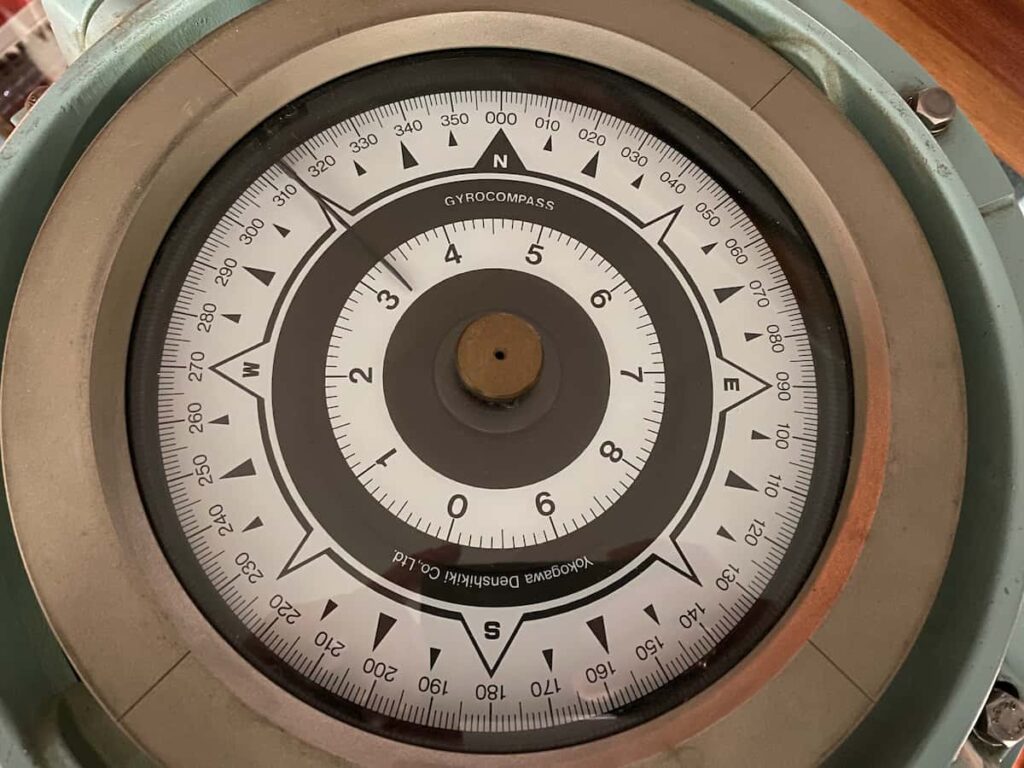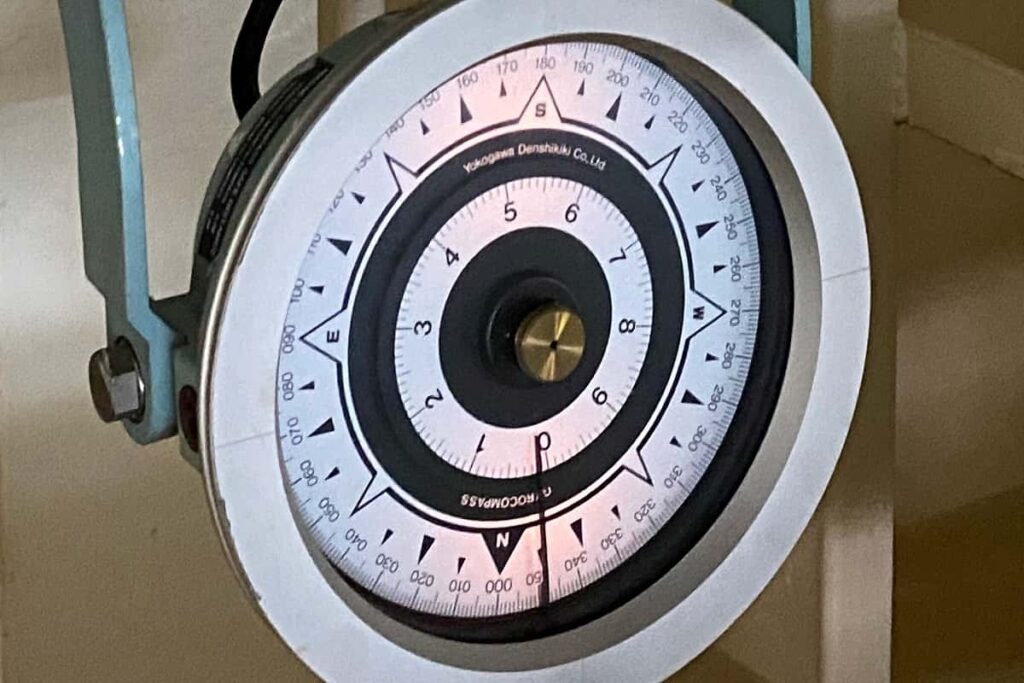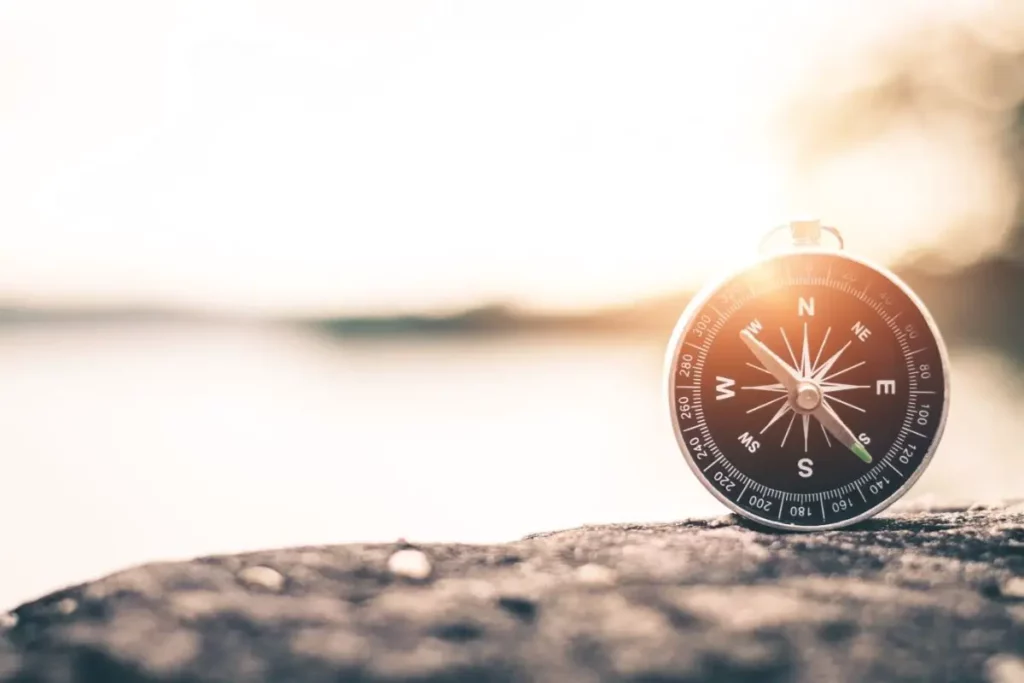For those fascinated by maritime navigation, the term ‘boxing the compass’ might sound familiar. But what exactly does it entail?
This traditional navigational practice, essential for mariners traversing the seas, involves mastering all 32 points of the compass.

While modern navigators predominantly rely on 360° angles for course-plotting, a select few sailors maintain the tradition of reciting every compass point from memory, echoing the maritime practices of yore.
What Is Boxing The Compass?
Boxing the compass refers to the naming of all 32 points on the marine compass from due north in a clockwise direction.
During the golden age of seafaring, boxing the compass meant that sailors had to name all 128 points on the marine compass, which also included fractional points.
However, the practice has since been limited to 32 points, as this made the recital much easier.
In some marine academies today, boxing the compass is still taught as an important skill for novice sailors, as it shows respect for traditional seafaring methods.
But how do you box the compass? And what are the different compass points called? We have answered these questions and more in the section below…
How Do Compass Points Work?
The compass, an essential navigation tool, is mandatory on ship bridges and lifeboats as per SOLAS regulations.
Before we can teach you what boxing the compass means, you must first understand how compasses work.
While many people assume that compasses merely point us in the right direction, this is only a summary of the device and its capabilities.
Most compasses come with their own form of math, which can be used during maritime navigation.

In most cases, a standard 360° marine compass will have 32 points, which means the angular range of a single compass point equals 360°/32 = 11.25°.
For this reason, there is 11.25° between each point of the compass. Now that you understand the mathematics of using a compass, it’s time to take a closer look at what boxing the compass means.
How To Box The Compass?

Boxing the compass involves understanding its 32 points, divided into cardinal, inter-cardinal, half, and quarter points.
- Cardinal points
- Inter-cardinal points
- Half points
- Quarter (By) points
Now let’s take a look at the different points that fall under these categories and their various meanings.
Cardinal Points
These points are considered the most well-known, as they represent the four core directions of the marine compass:
- N (North) – 0 (360) degrees
- E (East) – 90 degrees
- S (South) – 180 degrees
- W (West) – 270 degrees
Cardinal points are located at right angles on compasses and remain the most familiar points for general navigation.
Intercardinal Points
The cardinal points and the intercardinal points come together to form the 8 principal points of the compass, which are commonly used around the world. The intercardinal points include the following 4 directions:
- NE (Northeast) – 45 degrees
- SE (Southeast) – 135 degrees
- SW (Southwest) – 225 degrees
- NW (Northwest) – 315 degrees
Intercardinal points are located between the cardinal directions, where they cut through the compass at bisecting angles.
Half Points
Half points can be obtained by cutting the angles of the 8 principal directions in half. They are lesser known than their often-used counterparts and play an important role in maritime navigation:
- NNE (North-northeast) – 22.5 degrees
- ENE (East-northeast) – 67.5 degrees
- ESE (East-southeast) – 112.5 degrees
- SSE (South-southeast) – 157.5 degrees
- SSW (South-southwest) – 202.5 degrees
- WSW (West-southwest) – 247.5 degrees
- WNW (West-northwest) – 292.5 degrees
- NNW (North-northwest) – 337.5 degrees
Quarter Points
You can obtain a further 16 points by cutting the angles between the 16 points above in half. These points are called quarter points, however, they are also known as by points.
If you want to learn more about these directions, you will find additional information in the bullet points below:
First Quadrant
- NxE (North by East) – 11.25°
- NExN (Northeast by North) – 22.5°
- NExE (Northeast by East) – 33.75°
- ExN (East by North) – 56.25°
Second Quadrant
- ExS (East by South) – 101.25°
- SExE (Southeast by East) – 112.5°
- SExS (Southeast by South) – 123.75°
- SxE (South by East) – 146.25°
Third Quadrant
- SxW (South by West) – 191.25°
- SWxS (Southwest by South) – 202.5°
- SWxW (Southwest by West) – 213.75°
- WxS (West by South) – 236.25°
Fourth Quadrant
- WxN (West by North) – 281.25°
- NWxW (Northwest by West) – 292.5°
- NWxN (Northwest by North) – 303.75°
- NxW (North by West) – 326.25°
The 32 Points Of The Compass
There are 32 points on the marine compass, which are comprised of 8 principal points, 8 half points, and 16 quarter points.

Each point is at an 11.25° angle from the next angle and can be used as a means of navigation while traveling at sea.
If you want to try your hand at boxing the compass, we have provided this detailed guide to the different points, which includes their names, symbols, and degrees. The points are also in the correct order:
| Direction | Symbol | Degrees |
|---|---|---|
| North | N | 0 (360) |
| North by East | N by E | 11.25 |
| North Northeast | NNE | 22.5 |
| Northeast by North | NE by N | 33.75 |
| Northeast | NE | 45 |
| Northeast by East | NE by E | 56.25 |
| East Northeast | ENE | 67.5 |
| East by North | E by N | 78.75 |
| East | E | 90 |
| East by South | E by S | 101.25 |
| East Southeast | ESE | 112.5 |
| Southeast by East | SE by E | 123.75 |
| Southeast | SE | 135 |
| Southeast by South | SE by S | 146.25 |
| South Southeast | SSE | 157.5 |
| South by East | S by E | 168.75 |
| South | S | 180 |
| South by West | S by W | 191.25 |
| South Southwest | SSW | 202.5 |
| Southwest by South | SW by S | 213.75 |
| Southwest | SW | 225 |
| Southwest by West | SE by W | 236.25 |
| West Southwest | WSW | 247.5 |
| West by South | W by S | 258.75 |
| West | W | 270 |
| West by North | W by N | 281.25 |
| West Northwest | WNW | 292.5 |
| Northwest by West | NW by W | 303.75 |
| Northwest | NW | 315 |
| Northwest by North | NW by N | 326.25 |
| North Northwest | NNW | 337.5 |
| North by West | N by W | 348.75 |
For example, 292.5 degrees on a compass is West Northwest and marked with 3 letters WNW.
How Do You Convert Degrees To One Of The 32 Points Of A Compass?
As I mentioned above, each compass point is at an 11.25° angle. So you can just divide degrees by 11.25 and count compass points from the North bearing. N, N by E, NNE, NE by N, NE, NE by E, ENE, E by N, E, E by S, ESE, SE by E, SE, SE by S, SSE, S by E, S, S by W, SSW, SW by S, SW, SE by W, WSW, W by S, W, W by N, WNW, NW by W, NW, NW by N, NNW, N by W.
Remembering all 32 compass points or counting them may lead to a mistake, so it is preferable to understand the logic of compass points and make conversation from 4 cardinal points (N, E, S, and W), 8 intercardinal points (N, NE, E, SE, S, SW, W, and NW) or 16 Quarter points.
Here is a complete table of 32 compass points that will ease conversation from degrees to any of the 32 points of a compass.
| Degrees | Divided by 11,25 | Direction | Symbol |
|---|---|---|---|
| 0 (360) | 0 | North | N |
| 11.25 | 1 | North by East | N by E |
| 22.5 | 2 | North Northeast | NNE |
| 33.75 | 3 | Northeast by North | NE by N |
| 45 | 4 | Northeast | NE |
| 56.25 | 5 | Northeast by East | NE by E |
| 67.5 | 6 | East Northeast | ENE |
| 78.75 | 7 | East by North | E by N |
| 90 | 8 | East | E |
| 101.25 | 9 | East by South | E by S |
| 112.5 | 10 | East Southeast | ESE |
| 123.75 | 11 | Southeast by East | SE by E |
| 135 | 12 | Southeast | SE |
| 146.25 | 13 | Southeast by South | SE by S |
| 157.5 | 14 | South Southeast | SSE |
| 168.75 | 15 | South by East | S by E |
| 180 | 16 | South | S |
| 191.25 | 17 | South by West | S by W |
| 202.5 | 18 | South Southwest | SSW |
| 213.75 | 19 | Southwest by South | SW by S |
| 225 | 20 | Southwest | SW |
| 236.25 | 21 | Southwest by West | SE by W |
| 247.5 | 22 | West Southwest | WSW |
| 258.75 | 23 | West by South | W by S |
| 270 | 24 | West | W |
| 281.25 | 25 | West by North | W by N |
| 292.5 | 26 | West Northwest | WNW |
| 303.75 | 27 | Northwest by West | NW by W |
| 315 | 28 | Northwest | NW |
| 326.25 | 29 | Northwest by North | NW by N |
| 337.5 | 30 | North Northwest | NNW |
| 348.75 | 31 | North by West | N by W |
Traditional Mediterranean and Chinese Compass Points
Beyond the widely recognized compass points, historical navigation also embraced diverse systems like the Traditional Mediterranean and Chinese compass points.
Two of these systems are the Traditional Mediterranean compass points and the Chinese compass points. Understanding these ancient navigation methods provides insight into the diverse approaches to maritime navigation that existed before the modern compass became widely adopted.
Traditional Mediterranean Compass Points
In the Mediterranean region, a compass rose known as the “Wind Rose” was used for navigation.
The ancient Greeks and Romans used a system based on 12 wind deities known as Anemoi in Greek mythology. These winds were used to represent the cardinal and intercardinal points of the compass. The primary winds included:
- Boreas (N) – North
- Eurus (NE) – Northeast
- Apeliotes (E) – East
- Notus (S) – South
- Zephyrus (W) – West
- Skiron (NW) – Northwest
- Kaikias (NE) – Northeast
- Lips (SW) – Southwest
Each of these primary winds was associated with a specific direction, and the compass rose was designed accordingly. It is worth noting that this system evolved, and various cultures in the Mediterranean adopted their variations.
Chinese Compass Points
The invention of the compass is attributed to ancient China, where it was initially used for geomancy and divination purposes.
The Chinese compass, also known as the “luopan,” has a unique design and features the Chinese characters for the cardinal directions: North (北), South (南), East (东), and West (西). The Chinese compass was not only used for navigation but also played a significant role in Chinese philosophy, especially in the practice of feng shui.
In Chinese compass points, there are 24 primary divisions, each representing 15 degrees. These are further divided into 72 divisions, each representing 5 degrees. Some of the primary divisions include:
- Due North (0°)
- East-Northeast (45°)
- Due East (90°)
- East-Southeast (135°)
- Due South (180°)
- West-Southwest (225°)
- Due West (270°)
- West-Northwest (315°)
It is important to note that the Chinese compass also incorporates elements from Chinese cosmology, such as the Five Elements (Wood, Fire, Earth, Metal, and Water) and the Eight Trigrams (Bagua).
Understanding the Traditional Mediterranean and Chinese compass points sheds light on the diverse navigation methods used throughout history. While modern compasses have largely replaced these ancient systems, it is essential to recognize and appreciate the knowledge and traditions that have contributed to our current understanding of maritime navigation.
Today, ‘boxing the compass’ serves as a crucial tool for precise communication in navigation, ensuring clarity and accuracy in maritime operations.
Mariners use detailed compass points to describe wind directions, set courses, and report bearings with greater accuracy.
This practice is especially important in situations where precise navigation is crucial, such as in poor visibility or when navigating close to hazards. It ensures that all crew members have a clear and exact understanding of directions, which is vital for safe and efficient maritime operations.
In Summary
Although the practice of boxing the compass is not as prevalent as in the past, it continues to be cherished by a dedicated few, bridging maritime heritage with modern navigation.
Nowadays, mariners use machines and equipment to determine their location, which means the need for compasses is starting to dwindle.
And while it is easier to use our advancements in technology, we should also not forget the methods used by our seafaring descendants.
We can only hope that boxing the compass remains a maritime tradition, even in a world where knowing such information is no longer needed
- Types of Gas Carriers as per IGC Code – April 22, 2025
- Wind-Assisted Propulsion Systems (WAPS): A Game Changer for Maritime Decarbonization – February 6, 2025
- 10 Boat Salvage Yards in California – January 25, 2025



